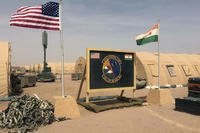MARINE CORPS BASE QUANTICO, Va. -- While rain fell softly onto the tree branches overhead, Maj. Justin Betz, air officer for The Basic School, adjusted his headset and dialed in his hulking, green hand radio for contact.
As he carefully walked up a steep hill beside a mix of grass and mud called LZ-7, Betz’s eyes scanned the skies looking for incoming aircraft.
“We rarely get Ospreys out here at TBS,” said Betz. “So it’s a real treat to our students and even our permanent personnel.”
Suddenly, three MV-22 Ospreys, the distinct helicopter-plane hybrid, broke over the tree line and quickly covered ground toward the landing zone.
Betz raised a neon-orange landing panel to mark the LZ, making sure the pilots knew they were in the right place; else he risked an expensive U-turn.
Marines from Marine Medium Tiltrotor Training Squadron 204, flying out of Marine Corps Air Station New River, visited TBS on Aug. 26, 2013, to allow students in Basic Officers Course a chance to see the aircraft up close and also fulfill some of the unit’s professional military education requirements.
“All Marines who have any stake on the Osprey are trained at VMMT-204; from pilots, to the crew and maintainers” said Lt. Col. Brett Hart, commanding officer of Marine Medium Helicopter Training Squadron 204. “Here, today we have 45 of the Corps’ specialists on the matter, and we’re here to pass on some of what we know to the Marines in [the Basic Officers Course].”
While the majority of the visitors stowed their gear in a nearby barracks, some of the Raptors, a unit nickname born from the bird of prey on their unit insignia, stayed behind for a static display for curious students to walk through and ask questions about the unit and Osprey operations.
Groups soon gathered around the rear of the dual-rotor aircraft, where Marines such as Cpl. Bryan Harris, a V-22 electrical systems technician, waited to answer questions.
“Doing things like this gives Marines some exposure to an aircraft they may never get otherwise,” Harris said. “Exposure is important especially for the Marines in [the Basic Officers Course] potentially going to flight school.”
According to Harris, the visit served not only the lieutenants of The Basic School, but the Marines of VMMT-204 as well. Following the static display and PME, the Raptors visited Marine Barracks 8th & I for an Evening Parade and The National Museum of The Marine Corps the morning after.
“Some of our Marines have never seen an evening parade, and others have never been to the National Museum of the Marine Corps,” said Sgt. Steven Orth, a crew chief with VMMT-204. “The [commanding officer] would call us the workhorse of the unit, so when we get a chance to share and experience our own history while cutting loose, we leap at it.”
Two days after their arrival, the Raptors boarded their gunships and rose into the sky from which they came, in the iconic, hybrid aircraft pioneered by the Marine Corps. Now, each of them carried home a new grasp on their place in the Corps.




























